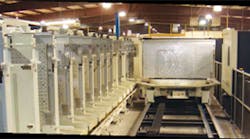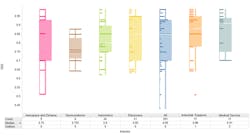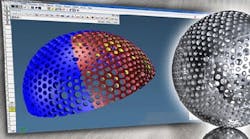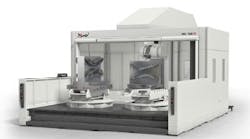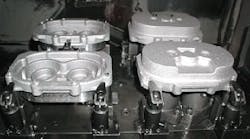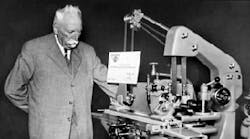| • Weaver manufacturing Co. • Wichita, Kan. • www.weavermfg.com • Number of employees —132 • 2008 sales —$36 million • Market served — Aerospace |
As a key player in the highly competitive aerospace market, Weaver Manufacturing Inc. sets itself apart by what it actually sells to customers.
Besides parts and machining time, the shop sells customers business partnerships supported by manufacturing processes that allow Weaver to react quickly to fulfill customer needs.
Weaver vice president David May said shops have to stay focused on customers and really listen to what they are saying.
“You have to understand the direction customers are headed and keep in mind that they are the people that can hire and fire you,” May said.
He also stressed the importance of investing in employees, not only through training but also through communication.
Information travels both up and down the corporate ladder at Weaver, and quite often, good ideas come from the employees on the shop floor. These ideas, in turn, help the shop better serve customers.
Weaver started in 1942, employs 133 people, and is a 100-percent aerospace shop, serving the industry as a Tier 1 and Tier 2 supplier. But the shop is extremely diversified within that market, and no one customer dominates more than 30 percent of its business.
May said that its customer partnerships require a lot of relationship building and time working to align Weaver’s strategies with its customers’.
The shop’s personnel spend time at customer facilities, and customers send people to Weaver, in an effort to help streamline processes at both facilities.
For its customers, Weaver supplies parts that are small and simple to complex ones that could measure 160 in. by 120 in. and require high-speed, 5-axis hog-out work. It also provides value-added services such as kitting and assembly of mechanical and electrical components.
Job lot sizes average from 10 to 20 pieces, but can also range from one piece to more than 5,000 parts. Weaver delivers most jobs within a minimum-maximum window. It monitors customer inventory levels and will deliver as needed to maintain certain operational levels.
“It is important for us to manage our business, and all our customers give us a 24-month forecast,” May said. To manage its long-running repeat jobs, he said the shop relies heavily on its MRP and ERP software system from Epicor.
The shop’s goal is to put as much single-point information into that system, and to use the data and resources to run and improve the business, May said. Plus, once a month, the shop reevaluates processes as far as cost effectiveness is concerned, again relying on its ERP system to do that.
“Many manufacturing facilities conduct off-line reporting that can consume a great deal of indirect labor. We try to eliminate that with our system. We are working diligently to becoming as digitally focused as possible. Transferring workflow into a digital format so that information is retained at a single point for access and storage,” he said.
All parts are customer designed, but Weaver provides manufacturing feasibility and any other kind of guidance, such as recommending a particular material.
Some of the manufacturing technologies that allow Weaver to support its customers and turn jobs around in four to eight weeks include high-speed (30,000 rpm and over 1,000-ipm feedrates) 5-axis machining cells with pallet systems and standardized tooling and fixturing.
Weaver has a total of 31 spindles, 14 of which are housed in the company’s south building. The building’s 5-axis machining cells include one that consists of a Mazak Variaxis trunion-style machine with an RGV that tends a 24-pallet work loading system, and another cell that has multiple Makino MAG 3 machines that are supported by 16 pallets, each of which measure 60 in. by 120 in.
Both of those machining cells provide full, infinite C-axis rotation that allows Weaver to do more machining without having to reposition parts. May said that ability also produces higher quality parts.
Cell pallet systems run in full automatic mode. The shop loads several jobs into the cell controller, and lets it handle job-run scheduling based on due dates and priorities.
The MAG 3 machine tables are horizontally orientated for part loading. They then move to an upright vertical position inside the machine. That setup is especially advantageous for large amounts of metal removal, as is the case with Weaver’s large, aluminum monolithic aerospace parts.
“Our goal is to reduce non-valueadded time, which means shortening setup times,” Derek Shriver, shop foreman at Weaver said. “The cell systems let us changeover jobs while machine spindles keep working. And for our non-cell systems, we reduce changeover time using standard dovetail fixturing and sub-plates with grid patterns that instantly locate workpieces.”
Shriver said the shop uses standard tooling for jobs that have multiple parts running across the common fixtures, and standard tooling for its cells. When a new cutter is added, its harmonics are tested, and the necessary settings are entered into the machining program.
“The more you can use common fixturing and standard tool lists, the more repeatability you maintain from part to part process. Even better, our guys on the shop floor know what to look for and can see if something deviates from the standard, which naturally reduces setup times,” Shriver said.
In what May said appears to be a growing trend, many of Weaver’s customers are providing 3D model-based definitions for their parts.
Instead of getting full-blown CAD models, Weaver gets models that simply list specific key part-feature tolerances to hold, while the rest of the features can be held to an overall tolerance. There are no dimension drawings, and Weaver has to build its own drawings, manufacturing and inspection plans, and first article drawings ballooned up.
Shriver and his team streamline designs and flows of customer part models and design a process to take a part from order to the shop floor. Then they produce a value-stream map to lean-out that process.
For one customer part, Shriver and his team took the process from a linear one to a more parallel process in which all the job aspects were better integrated within each other.
As a result, going from order to shop floor was reduced from an estimate of 20 to 40 weeks to 10 weeks, and, that also reduced the transaction costs involved.
Weaver pushes through several new jobs in addition to its repeat long-run orders. This year, the shop averaged about 60 new part numbers per month.
